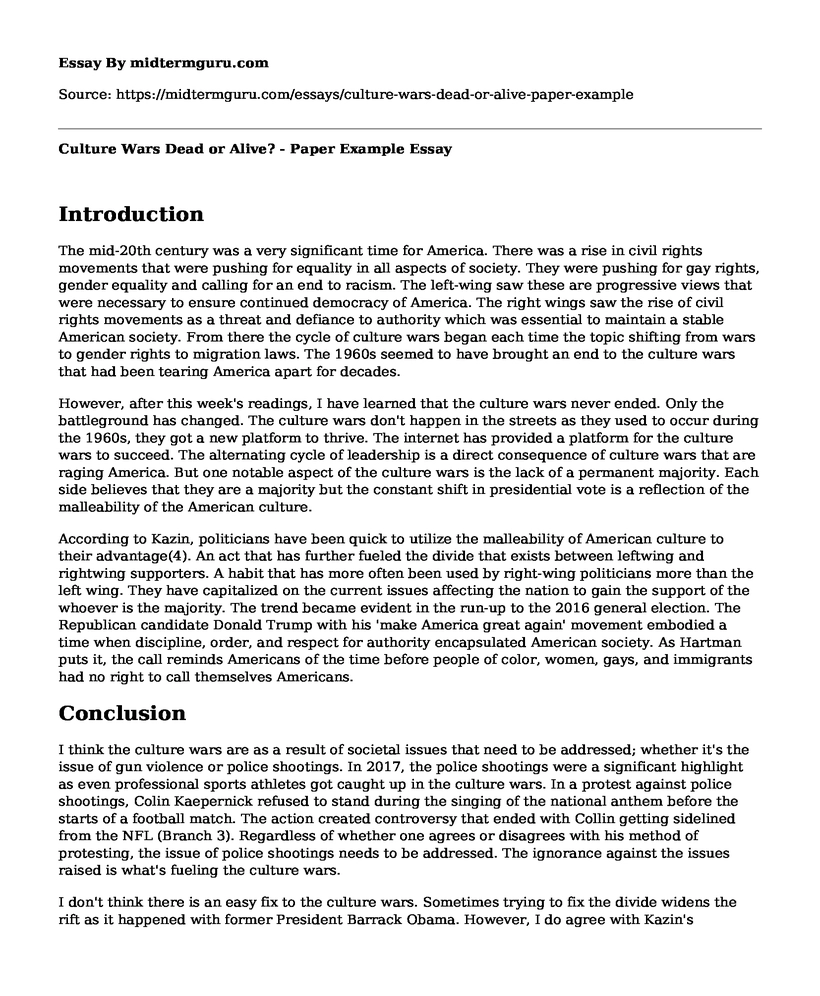Introduction
The mid-20th century was a very significant time for America. There was a rise in civil rights movements that were pushing for equality in all aspects of society. They were pushing for gay rights, gender equality and calling for an end to racism. The left-wing saw these are progressive views that were necessary to ensure continued democracy of America. The right wings saw the rise of civil rights movements as a threat and defiance to authority which was essential to maintain a stable American society. From there the cycle of culture wars began each time the topic shifting from wars to gender rights to migration laws. The 1960s seemed to have brought an end to the culture wars that had been tearing America apart for decades.
However, after this week's readings, I have learned that the culture wars never ended. Only the battleground has changed. The culture wars don't happen in the streets as they used to occur during the 1960s, they got a new platform to thrive. The internet has provided a platform for the culture wars to succeed. The alternating cycle of leadership is a direct consequence of culture wars that are raging America. But one notable aspect of the culture wars is the lack of a permanent majority. Each side believes that they are a majority but the constant shift in presidential vote is a reflection of the malleability of the American culture.
According to Kazin, politicians have been quick to utilize the malleability of American culture to their advantage(4). An act that has further fueled the divide that exists between leftwing and rightwing supporters. A habit that has more often been used by right-wing politicians more than the left wing. They have capitalized on the current issues affecting the nation to gain the support of the whoever is the majority. The trend became evident in the run-up to the 2016 general election. The Republican candidate Donald Trump with his 'make America great again' movement embodied a time when discipline, order, and respect for authority encapsulated American society. As Hartman puts it, the call reminds Americans of the time before people of color, women, gays, and immigrants had no right to call themselves Americans.
Conclusion
I think the culture wars are as a result of societal issues that need to be addressed; whether it's the issue of gun violence or police shootings. In 2017, the police shootings were a significant highlight as even professional sports athletes got caught up in the culture wars. In a protest against police shootings, Colin Kaepernick refused to stand during the singing of the national anthem before the starts of a football match. The action created controversy that ended with Collin getting sidelined from the NFL (Branch 3). Regardless of whether one agrees or disagrees with his method of protesting, the issue of police shootings needs to be addressed. The ignorance against the issues raised is what's fueling the culture wars.
I don't think there is an easy fix to the culture wars. Sometimes trying to fix the divide widens the rift as it happened with former President Barrack Obama. However, I do agree with Kazin's conclusion; that culture wars, like all other wars, will rarely end with a settlement that pleases both sides(6). The only way to end the culture wars is for either side to find a lasting victory.
Works Cited
Branch, John. "The Awakening of Colin Kaepernick." The New York Times (2017): 1-26. e-copy. 5 November 2018. <https://www.nytimes.com/2017/09/07/sports/colin-kaepernick-nfl-p...>.
Hartman, Andrew. The Culture Wars are Dead. 27 August 2018. e-copy. 5 November 2018.
Kazin, Michael. "America's Never-Ending Culture War." New York Times (2018): 1-6. e-copy. 5 November 2018. <https://www.nytimes.com/2018/08/24/opinion/sunday/chicago-protes...>.
Cite this page
Culture Wars Dead or Alive? - Paper Example. (2022, Sep 26). Retrieved from https://midtermguru.com/essays/culture-wars-dead-or-alive-paper-example
If you are the original author of this essay and no longer wish to have it published on the midtermguru.com website, please click below to request its removal:
- The Lie about College Diversity - Essay Sample
- Blacking Up Hip Hop: Documentary Analysis Essay
- The Need for a Developmentally-Appropriate Multicultural, Anti-Bias Classroom - Essay Sample
- Diversity in Sociology: Respect and Acceptance for a Changing World - Essay Sample
- Maximizing Business Outcomes Through Cultural Diversity - Essay Sample
- Exploring Diversity in the Workplace: Michelle Barfield's Case Study
- Maximizing Learning Outcomes in Culturally and Linguistically Diverse Settings - Essay Sample







